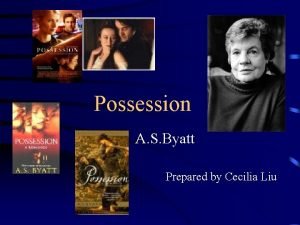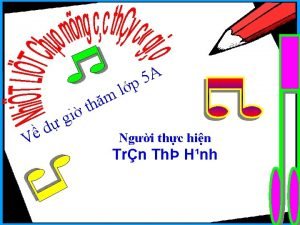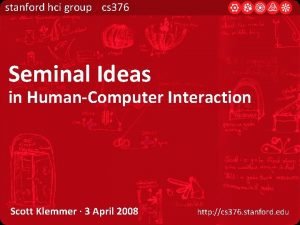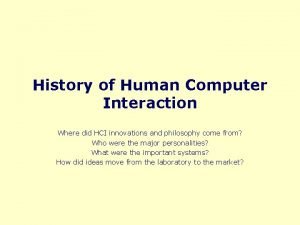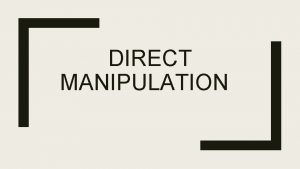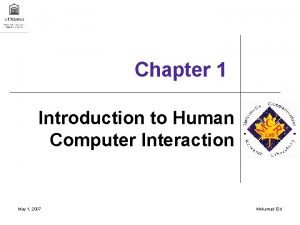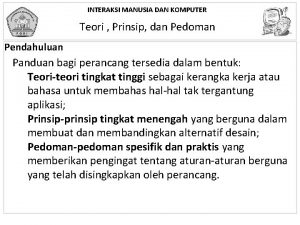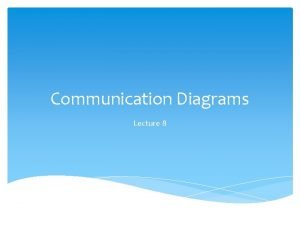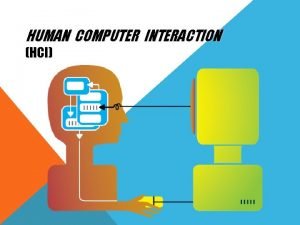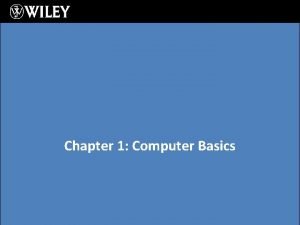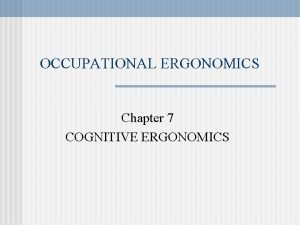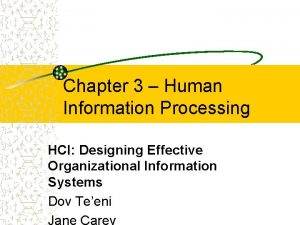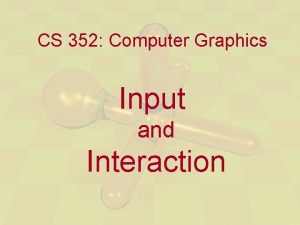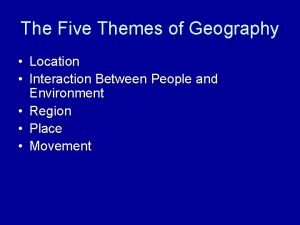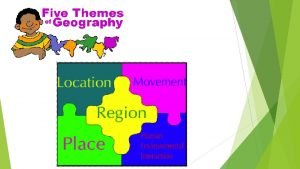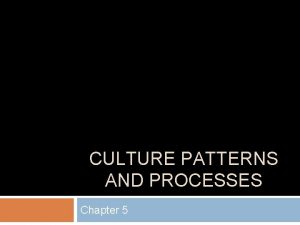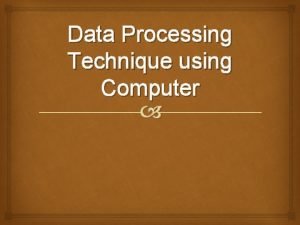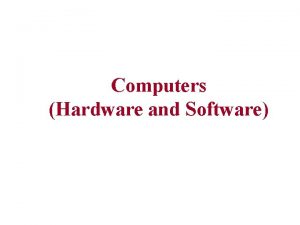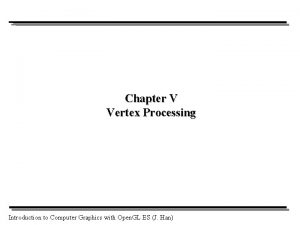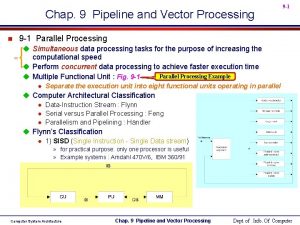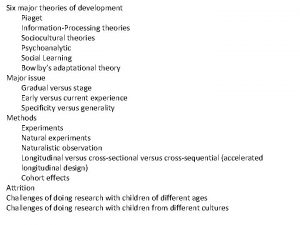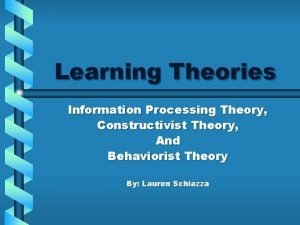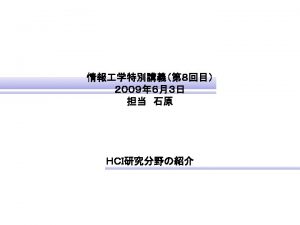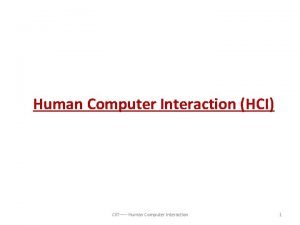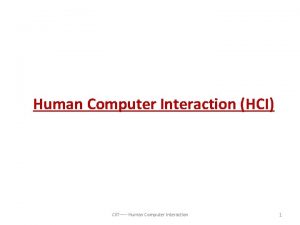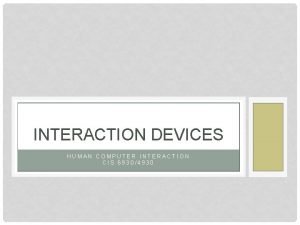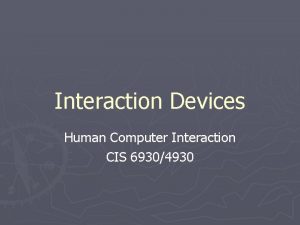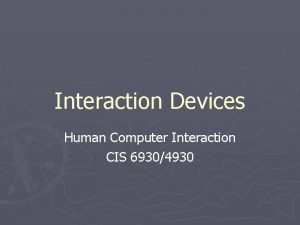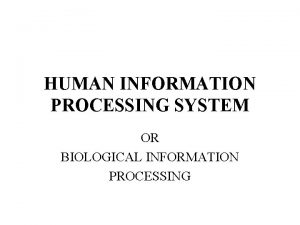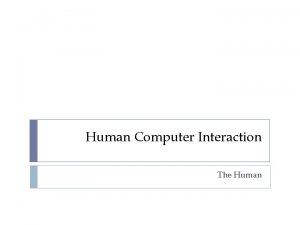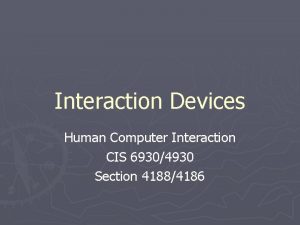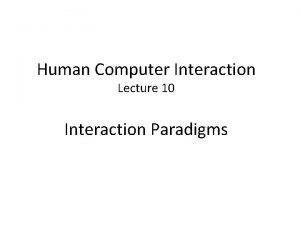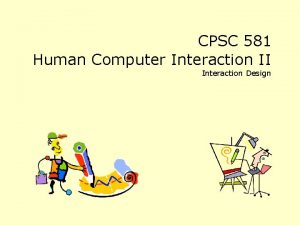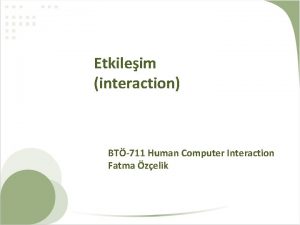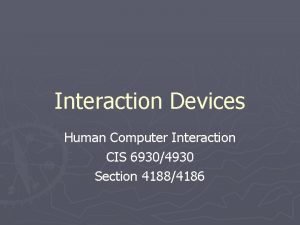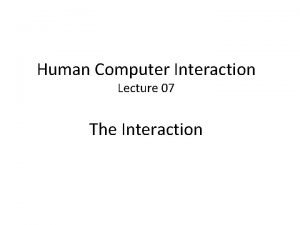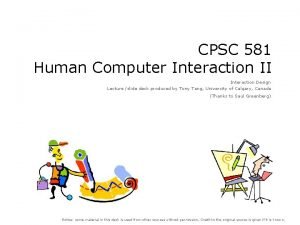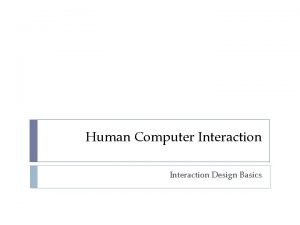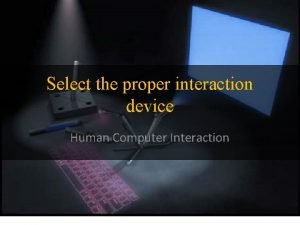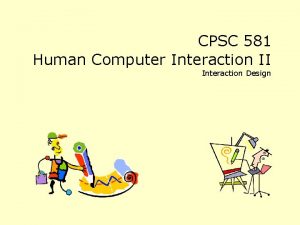Human Information Processing Li Liu Human Computer Interaction


























































- Slides: 58

Human Information. Processing Li Liu

Human Computer Interaction ”Human Information Processing” How much information can she receive?

Case 1

Personal Area Network


Principle


Speech – Control Technology Name Dialing Hand Free

Speech Recognizer ”repeat”

Speech Signal Waveform

Effect of Background Noises

Performance Words Correct Rate (%) 100 0 -30 Speech-to-Noise Ratio (d. B) 0

Lip Tracker

Performance of Speech Recognition Words Correct Rate (%) 100 Auditory and visual cues Auditory cues only 0 -30 Speech-to-Noise Ratio (d. B) 0

How to Design A Headset? Tip ?

Mobile Phones

Braille Code for English

Tactile Display

Problem: Usable? Efficiency? Reliability?

Braille Code for English

How Many Letters Can be Represented?

Combination

Tactile Pins

Braille Code for English W=2. 4093 The average number of active tactile pins. Wopt=1. 2118 Letters in written English

New Code W=1. 2316




Information

Information Theory If all eight horses are equally good, then the chance for a horse to win the race is 1/8! What is the probability? The probability for a horse to win is Pi=1/8

Information Theory If a horse wins the game, how much information is it given? How to measure information?

Measure of information 1/8 1/8 • A source A={a 1, a 2…a. N} the probability of each event P={P 1, P 2…PN} • More information if Pi is low, less information is Pi is high 1/2 1/4 1/8 1/16 • I(ai)=log(1/Pi) is called self information

Entropy 1/8 1/8 1/2 1/4 1/8 1/16 Taking the mean value over all symbols with the alphabet

Communication Theory I H R source If R < H error-free representation impossible!

Coding 1/8 1/8 000 001 010 111 1/2 1/4 1/8 1/16 0 10 1110 111101 111110 111111

How much information does a picture contain? 255 254 0

How much information does a picture contain? Suppose the size of a picture is 256 x 256, And each pixel is represented by 8 bits, then Total bits to represent such a picture is 8 x 256= 524288 bits/picture How many pictures can be represented by a half Mbits? 010011010100001110101010. . . Total number of pictures 2524288 = 10158000

How many pictures have human beings been perceived Up to now, the number of all pictures which have been perceived by human beings is only 1019 <<< 10158000 Assume that 30 frames of pictures per second are perceived by human eyes. If the average life-span is 70 years and 8 hours per day are spent on sleep, then about 108 frames are received by one person in all his/her life. Furthermore, if the total number of human beings who lived in the earth is 1011, then, the total number of all pictures which have been perceived by human beings is only 1019.

Entropy of an image probability intensity 45 123 208 001 00010 00011 H=6. 9

Entropy of human face images A face image = 50 bytes (400 bits) !

Communication

Brain Wave H C source channel

Communication Channel Abstract Channel Model Ex. Noiseless Binary Channel Capacity C= 1 bit 0 0 1 1

Communication Channel Abstract Channel Model Ex. Noisy Binary Channel 0 Channel Capacity 1 C= 1 + p log 2 p + (1 -p) log 2 (1 -p) bits 1 -p p p 1 -p 0 1

Communication & Design receiver transmitter

Different Decoders ”When a group of people look at an object, none of them sees exactly the same thing as anyone else. Even if they receive approximately the same image on their retina and interpret the image in basically the same way, this image is always revised by the observer’s personality and situation. ” Rune Monö

Real-World Channel Model Ex. Band-limited Gaussian Channel Y(t) X(t) Z(t) Gaussian noise C = Wlog 2(1+P/N) bits/s W: channel bandwidth P/N: signal to noise ratio

Real-World Channel Model Telephone signals are band-limited to 3300 Hz and have a SNR of 20 d. B (P/N=100), C=3, 300 log (1+100)= 22, 000 bits/s Practical modems achieve transmission rates up to 19, 200 bits/s

Communication Theory II H Source R C Channel If H <= C lossless transmission possible If H > C lossless transmission impossible!


Brain Wave

Information Rate Sensory Bandwidth sensation Perceptual Bandwidth data perception information Cognitive Bandwidth cognition knowledge

Information Rates Sense Information Stream Bits/s Vision 10. 000 Hearing 100. 000 Touch 10. 000 Smell 1. 000 Taste 1. 000 Sense Bandwidth of consciousness bits/s vision 40 hearing 30 touch 5 Taste and smell 1

Channel=”Bandpass Filter”

Effect of Bandpass Effect of degrading the speech signal by spectral filtering The original speech signal contains significant energy up to 7 k. Hz a) signal bandpass filtered (0. 25 - 0. 75 k. Hz) b) signal bandpass filtered (1. 0 – 3. 0 k. Hz) c) original signal

Bandpass System Most long-haul transmission systems have a bandpass Frequency response The transfer function can be written as R =C L where the resonant frequency fo and quality factor Q are The 3 d. B bandwidth between the lower and upper cutoff 1. 0 0. 707 frequencies is B fl fo fu f

Bandpass System Since practical tuned circuits usually have 10 < Q <100, the fractional bandwidth B/fc should be kept within the range As a rough rue of thumb, the carrier frequencies and corresponding nominal bandwidth can be

Bandpass System Selected carrier frequencies and nominal bandwidth Frequency band Longwave radio Carrier frequency Bandwidth 100 k. Hz 2 k. Hz 5 MHz 100 k. Hz 100 MHz 2 MHz 5 GHz 100 MHz Millimeterwave 1 00 GHz 2 GHz Optical 5 x 1014 Hz 1013 Hz Shortwave radio VHF Microwave
 Alex liu cecilia liu
Alex liu cecilia liu Líu líu lo lo ta ca hát say sưa
Líu líu lo lo ta ca hát say sưa Mit csail hci course review
Mit csail hci course review Icons in hci
Icons in hci Interaction paradigms
Interaction paradigms Input output channels in hci
Input output channels in hci History of human computer interface
History of human computer interface What is direct manipulation
What is direct manipulation Hci chapter 1
Hci chapter 1 Evolusi antarmuka pada level pemrograman pada tahun
Evolusi antarmuka pada level pemrograman pada tahun Prinsip imk
Prinsip imk Interaction design syllabus
Interaction design syllabus Model konseptual
Model konseptual Alan dix
Alan dix Human computer interaction diagram
Human computer interaction diagram Ergonomics in human computer interaction
Ergonomics in human computer interaction Hci merupakan
Hci merupakan Information processing cycle of computer
Information processing cycle of computer Human information processing model in hci
Human information processing model in hci Human information processing model ergonomics
Human information processing model ergonomics Human information processing hci
Human information processing hci Interaction in computer graphics
Interaction in computer graphics Bottom up vs top down processing
Bottom up vs top down processing Bottom up processing vs top down processing
Bottom up processing vs top down processing Bottom-up processing example
Bottom-up processing example Point processing operations
Point processing operations Example of secondary processing
Example of secondary processing Fractal image
Fractal image Histogram processing in digital image processing
Histogram processing in digital image processing Parallel processing vs concurrent processing
Parallel processing vs concurrent processing Nonlinear image processing
Nonlinear image processing What is point processing in digital image processing
What is point processing in digital image processing Morphological processing in digital image processing
Morphological processing in digital image processing Bottom up processing
Bottom up processing Batch processing vs interactive processing
Batch processing vs interactive processing H.e.i geography definition
H.e.i geography definition Spatial interaction ap human geography
Spatial interaction ap human geography Portland oregon human environment interaction
Portland oregon human environment interaction Spatial interaction ap human geography
Spatial interaction ap human geography The nile river map
The nile river map Spatial interaction ap human geography
Spatial interaction ap human geography What is geography
What is geography Dialect ap human geography
Dialect ap human geography Perceptual region definition
Perceptual region definition Human environment interaction
Human environment interaction Human environment interaction
Human environment interaction Expansion diffusion def
Expansion diffusion def Rome human environment interaction
Rome human environment interaction Computer vision vs image processing
Computer vision vs image processing Data processing in computer
Data processing in computer Computer processing cycle
Computer processing cycle Four major data processing functions of a computer
Four major data processing functions of a computer Vertex processing in computer graphics
Vertex processing in computer graphics Pipeline processing in computer architecture
Pipeline processing in computer architecture Examples of commercial data processing
Examples of commercial data processing Pipeline and vector processing
Pipeline and vector processing Information processing theory by atkinson and shiffrin
Information processing theory by atkinson and shiffrin Information processing theory
Information processing theory Cavr audit
Cavr audit
